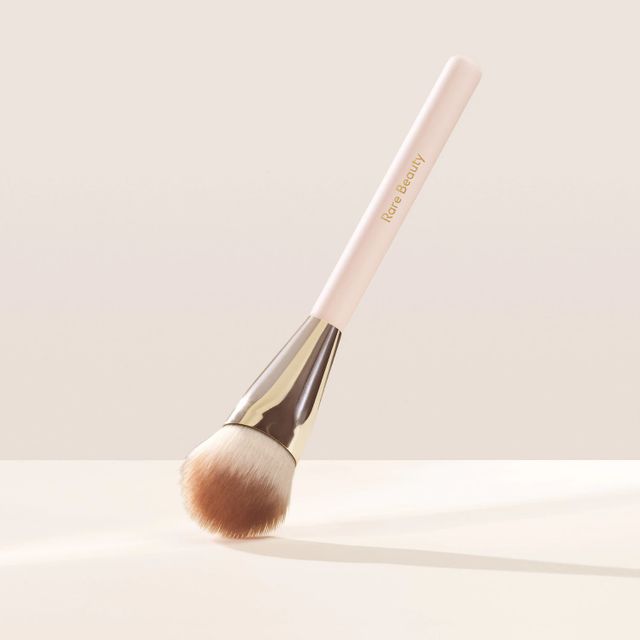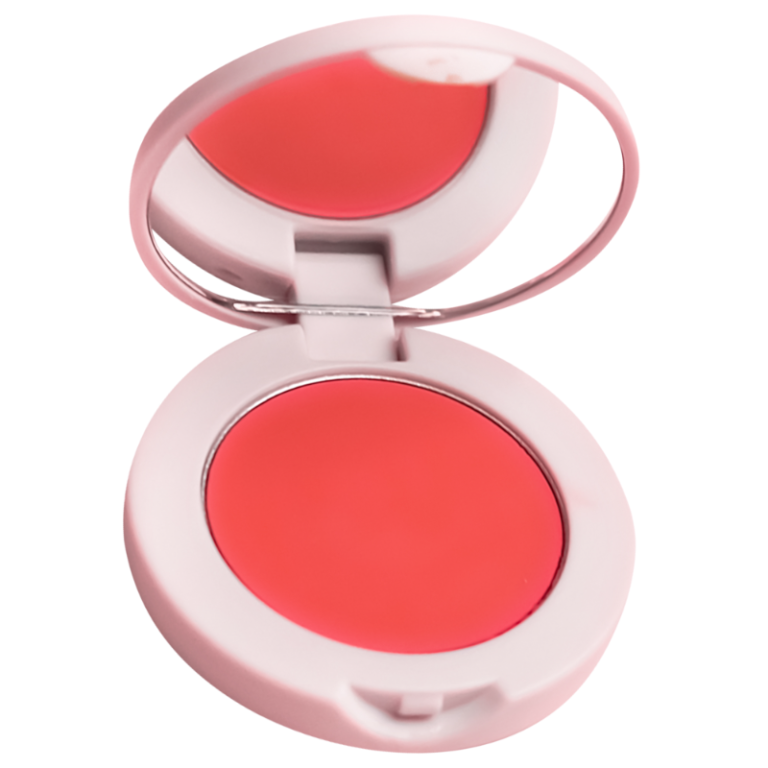
Choosing the Right Blush Brush: Natural vs Synthetic
Types of Blush Brushes and Their Uses
Choosing the best blush brush can be puzzling with so many options. But, knowing each type’s purpose helps.
- Domed Brushes: These provide a soft application, perfect for a natural look. Swirl them gently over powder blush and sweep onto cheeks.
- Angled Brushes: Ideal for contouring, they define cheekbones sharply. Use them for applying blush as well as bronzer along cheek hollows.
- Fan Brushes: Light and feathery, fan brushes are for a whisper of color. They’re excellent for finishing touches or a very sheer layer of blush.
- Tapered Brushes: A precise tool for focused application. They apply color exactly where you want it, avoiding a broad sweep.
Knowing the brush type you need comes down to the effect you’re aiming for. A domed brush works wonders for a diffused, soft-focus finish. An angled brush suits those who want to define and sculpt their features. A fan brush is your go-to for a minimalistic, barely-there blush application. Lastly, a tapered brush gives control for a targeted flush. Always use the best blush brush at hand to achieve the desired look.
:max_bytes(150000):strip_icc()/MERITBrushNo.1TaperedBlendingBrush-f4fee6409f1e48cbb5aa5534992f4da2.jpg)
Materials of Blush Brushes: Natural vs Synthetic
When choosing the best blush brush, consider the bristle material. Brushes come in natural or synthetic bristles. Here’s what to know about each:
- Natural Bristles: Made from animal hair, natural brushes offer a soft, seamless application. They work well with powder blush for a blended, airbrushed effect. However, those with allergies or ethical concerns may avoid them.
- Synthetic Bristles: These are man-made fibers such as nylon or polyester. Synthetic brushes are hypoallergenic and suited for cream and liquid blushes. They’re easy to clean and often more affordable than natural options.
Your choice between natural or synthetic bristles depends on several factors. These include your skin type, the blush formula you use most often, and your personal preferences. Synthetic brushes are a good match for sensitive skin and precise application. They’re also cruelty-free, aligning with ethical beauty standards. Natural brushes, on the other hand, offer a luxurious application experience with powders. Remember to check brush quality before buying, and consider how it complements your blush formula and application style.
Brush Shapes and Density for Different Blush Formulas
The right brush shape and density can transform your blush application. Round brushes often suit pressed powder formulas best. They pick up a moderate amount of pigment for an even, buildable coverage. Flat brushes work well with loose powder, allowing you to tap off excess easily and apply lightly.
For cream blushes, opt for a stippling brush. Its dual fiber bristles offer a lightweight, airbrushed finish. Dense brushes have tightly packed bristles, making them better for highly pigmented or stick blushes. They provide more control and less fallout during application.
The goal is to match the blush formula to the brush density for optimal pickup and blend. Lightweight formulas need a brush that won’t overwhelm the product. Use denser brushes for cream or stick blushes to achieve precise, high-impact color where you want it.
Choosing the best blush brush also means considering the formula you use often. Stick with synthetic bristles for cream and liquid blush formulas. Stay with natural or mixed bristles for powders to get the most out of your product. For a professional finish, use the right brush for your chosen blush formula and technique.
The Importance of Brush Size for Precision Application
Choosing the best blush brush doesn’t stop at bristle type or shape. Brush size is crucial too, especially for precision application. A brush too large can apply blush beyond the desired area. Meanwhile, a small one may not diffuse color widely enough. Here’s how brush size affects your makeup precision:
- Small Brushes: They are excellent for targeting small areas, like the apples of the cheeks. They allow for precise placement and blending, making them ideal for detailed work.
- Medium-sized Brushes: These are versatile for applying blush to cheeks and blending edges. They strike a balance between precision and diffused application.
- Large Brushes: Large brushes are generally best for quick, all-over applications. They might not offer pinpoint accuracy but can create a natural, blended look across larger areas.
By matching the brush size to the specific application area, you can control how much product lands on your skin. This gives you the power to create a more sculpted or a more natural look. When choosing the best blush brush, consider the size that complements your application technique and the blush formula you’re using.
:max_bytes(150000):strip_icc()/EcotoolsPrecisionBlushbrush-5c5c719846e0fb0001dccf5a.jpg)
How to Evaluate Brush Quality and Durability
When selecting the best blush brush, inspect its quality and durability. This ensures longevity and a consistent makeup application. Here are key areas to focus on:
- Bristle Fall-out: Check if bristles shed by giving the brush a gentle shake. A high-quality brush should not lose bristles easily.
- Ferrule Stability: The ferrule is the metal band connecting bristles to the handle. It should feel secure and not wiggle to avoid bristles coming loose.
- Handle Integrity: A sturdy handle is essential. It should feel solid in your hand and not splinter or peel with use.
- Softness and Strength: Bristles should be soft on the skin but also resilient. They must return to their original shape after washing and use.
- Quality of Assembly: The overall construction should look seamless. Poorly glued or misaligned parts can affect brush performance and durability.
Regular checks will help keep your blush brush in top form. Brushes that meet these quality standards contribute to flawless makeup application and stand the test of time.
Maintaining Your Blush Brush: Cleaning and Storage
Keeping your best blush brush in excellent condition requires proper maintenance. Here’s how to clean and store your brush to extend its life.
- Regular Cleaning: Clean your brush after each use to prevent makeup build-up. Use a gentle brush cleaner or mild soap and lukewarm water. Swirl the brush in the solution and rinse until the water runs clear.
- Deep Cleaning: Once a week, do a deep clean. This removes oils and deeply embedded pigments. You can use a specialized brush shampoo or make a DIY cleaner with gentle ingredients.
- Drying Brushes: After washing, squeeze out excess water with a towel. Reshape the bristles and lay the brush flat to dry. Never stand brushes up to dry as water can loosen the glue in the ferrule.
- Storage Solutions: Store your brushes in a dry, cool place. Use a holder or a case to keep them dust-free. Ensure they have enough space to avoid deformation of the bristles.
By cleaning and storing your brushes correctly, you avoid bacteria build-up and keep the bristles in good shape. This care routine is crucial for the durability of your brush and purity of your makeup application.
Expert Tips for Flawless Blush Application with the Right Brush
Choosing the best blush brush is more than just about the brush itself. It’s also about how you use it. Here are expert tips to ensure you apply blush perfectly every time.
- Prep Your Skin: Start with a clean, moisturized face. Even with a good brush, makeup won’t blend well on dry skin.
- Tap Off Excess: After picking up blush on the brush, tap it lightly. This removes excess product and prevents over-application.
- Find Your Angle: Smile and apply blush to the apples of your cheeks. Then, blend towards your hairline for a natural look.
- Use the Right Motion: For powders, use a swirling motion. For creams, tap or stipple the brush on your cheeks.
- Build Color Gradually: Start with a light touch. Add more color slowly to avoid making it too intense too fast.
- Highlight Features: Use an angled brush to apply a lighter shade on top of cheekbones. This defines and highlights your face.
- Blending is Key: After application, blend edges with a clean brush. Blending makes the color look part of your skin, not just on top.
- Mind the Formula: Remember, the blush type affects how you use the brush. Powder blushes blend well with fluffy brushes. Creams need denser brushes for a smooth finish.
By following these tips and choosing the best blush brush, you’ll master the art of flawless blush application.
:max_bytes(150000):strip_icc()/BobbiBrownBlushBrush1-5c5c6e52c9e77c000159c27e.jpg)
Top Picks: Recommended Blush Brushes by Makeup Artists
In the quest for the best blush brush, guidance from makeup artists can be invaluable. They have tested and used various brushes and know which ones deliver top-notch results. Here are some top picks recommended by professionals:
- For a Natural Finish: Look for a medium-sized, domed natural bristle brush. Makeup artists recommend this for a soft, diffused look.
- For Sculpting: A smaller, angled synthetic brush can carve out cheekbones nicely. Use it for precise contouring and adding depth.
- For Cream Blushes: A stippling brush with a mix of dense and feathery bristles is a favorite. It blends cream blush seamlessly into the skin.
- For Full Coverage: A larger, dense round brush works well. It helps with the application of highly pigmented blushes.
- For Delicate Shimmer: Try a fan brush. It’s perfect for applying a light shimmer to the cheeks.
Each of these brushes has features that cater to specific blush applications. Those that come highly recommended often have a track record for quality and performance. Always consider what makeup artists use to achieve flawless looks. Their recommendations can help you select the best blush brush for your makeup routine.

